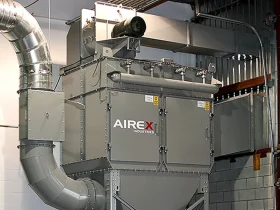PHARMACEUTICAL
Issues Encountered During Our Interventions
Humidity
Humidity level control is vital for the production of this application type.
Temperature
Some tasks require precise temperature control throughout product processing.
Dust
Particles generated by this application field accumulate quickly and must be addressed efficiently.
High Energy Consumption
Processes related to this application field consume high amounts of energy.
Air Change
To ensure ambient air quality standards, multiple air exchanges per hour are required.
Toxic
Exposure to substances released during the processing of a product is harmful to your short and long-term health.
Explosion Hazard
Dust particulate from some materials may be flammable and/or combustible.
The Pharmaceutical Industry And Its Contaminants: What Do You Need To Know?
When pharmaceutical products are manufactured, powders and pigments are gently handled on a daily basis. You must factor in many parameters when developing and designing your dust collection and ventilation systems. Consider these factors:
- Do you have adequate control over your internal environment, particularly in the cleanrooms? Temperature, moisture, and pressure are aspects to be monitored, as are the airflow characteristics.
- Your processes generate multiple types of particles that can create potentially harmful and explosive chemical mixtures; are you equipped to control the spread of them and reduce the risk of deflagration?
- Do your capture measures effectively prevent the proliferation of airborne micro-organisms or bioaerosols?
Are You Aware Of The Risks Associated With Your Processes?
You know as well as we do that your industry has its share of constraints. When you manufacture medications or other pharmaceutical products, you must deal with risks associated with particle, dust and bioaerosol emissions, while reducing cross-contamination. For example, contact between certain contaminants could cause a chemical reaction that triggers a fire or explosion. In addition to your processes, your facility’s air handling is important — from laboratories to storage — in order to prevent the products from breaking down.
The retention capacity of the filters in your dust collector is also an important aspect of your system’s performance. Another aspect is maintenance. Depending on the model, you will need to reduce human contact with the contaminated filter medium when replacing its filters or emptying the hopper under the dust collector. An additional challenge: preventing the particle-laden air from escaping during that maintenance. Among the various ways of protecting the workers’ breathing zone, replacing the filters with a “Bag-In/Bag-Out” solution can reduce this risk.



